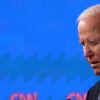The U.S., South Korean, and Japanese trilateral summit on the sidelines of the NATO summit signals progress on several key U.S. objectives in Asia.
Washington has long sought improved relations between Seoul and Tokyo to enable focusing on the common Chinese and North Korea threats, as well as both allies assuming a large regional security role.
The summit meetings come amid other encouraging signs for greater alliance cohesion in Asia.
The Daily Signal depends on the support of readers like you. Donate now
South Korean President Yoon Suk Yeol and Japanese Prime Minister Fumio Kishida will both make their countries’ first appearance at a NATO summit. Their participation at the June 28-30 meeting reflects a growing emphasis on cooperation among European and Asian democracies in dealing with Russian and Chinese challenges to their shared interests.
The NATO summit will adopt the “2022 Strategic Concept” delineating a security strategy against threats from China and Russia. In response to Chinese and domestic opposition criticism, Seoul denied that Yoon’s participation indicated an anti-China policy, but instead was intended to augment South Korea’s comprehensive security
On the sidelines of the NATO summit, the first trilateral meeting of U.S., South Korea, and Japanese leaders in nearly five years will take place. The leaders will discuss a consolidated approach to North Korea, including an allied response to an expected nuclear test by Pyongyang. U.S. and South Korean officials have stated that North Korea completed preparations for its seventh nuclear test, which could occur at any time.
Relations between America’s critically important Northeast Asian allies deteriorated following South Korean court rulings requiring liquidation of Japanese corporate assets to pay compensation for Japan’s 1910 to 1945 occupation of the Korean Peninsula. Tokyo retaliated by imposing export controls on South Korea, which, in turn, threatened to end bilateral military cooperation.
During the past year, the United States has engaged in extensive behind-the-scenes diplomacy to facilitate improved relations between Seoul and Tokyo. Washington’s efforts were helped by the election last month of the conservative Yoon. He pledged a forward-looking policy of reconciliation with Japan by separating contentious historic and sovereignty disputes from current common security threats.
In response to the growing North Korean threat, Yoon called for upgrading sharing of reconnaissance and intelligence assets and military cooperation with the U.S. and Japan. South Korean Foreign Minister Park Jin recently affirmed Seoul’s intent to restore the bilateral General Security of Military Information Agreement with Japan, which had been downgraded during the previous Moon Jae-in administration.
The U.S., South Korea, and Japan recently agreed to resume trilateral military exercises for the first time since 2017. South Korean and Japanese naval, air, and ground forces will participate in the U.S.-led Rim of the Pacific military exercise near Hawaii from June 29 to Aug. 4, including the Pacific Dragon trilateral ballistic missile defense exercise.
Senior U.S., South Korean, and Japanese defense officials agreed to identify additional opportunities for trilateral cooperation to promote a free and open Indo-Pacific region, including information-sharing and combined exercises.
There will, however, not be a bilateral South Korean-Japanese leaders meeting, which raised speculation of continued difficulties in fully resolving differences. The South Korean presidential office, however, downplayed the issue, indicating Japan’s upper house election next month had hindered necessary preparatory diplomatic meetings.
Both Yoon and Kishida have declared an intent to broaden their countries’ security responsibilities in the Indo-Pacific. Yoon looks set to abandon his predecessor’s reluctance to criticize Beijing’s encroachments of sovereignty in the East China and South China seas for fear of triggering economic retaliation and jeopardizing Chinese assistance in improving inter-Korean relations.
Yoon will abandon Moon’s fence-sitting attempt to balance Seoul’s relationship with Washington and Beijing and will instead more firmly align with the United States.
In recent years, Japan has augmented its military capabilities and steadily increased security cooperation and military exercises with Australia and other regional partners, as well as with France and the United Kingdom.
Meanwhile, momentum seems to be building for Japan to double its annual defense spending to 2% of its gross domestic product and to develop retaliatory strike capabilities against Chinese and North Korean attacks.
Washington should build on recent trilateral cooperation by proposing a 2+2+2 meeting of the U.S., South Korean, and Japanese foreign and defense ministers to develop joint strategies for responding to the North Korean and Chinese threats.
Early initiatives could include standardizing logistics-sharing and information-sharing protocols, as well as increasing the scope, type, and sophistication of trilateral military exercises.
The U.S. is stronger when aligned with its Indo-Pacific allies. Close trilateral coordination on security and foreign policies is critical for effective deterrence and defense capabilities.
Have an opinion about this article? To sound off, please email letters@DailySignal.com and we’ll consider publishing your edited remarks in our regular “We Hear You” feature. Remember to include the url or headline of the article plus your name and town and/or state.






























